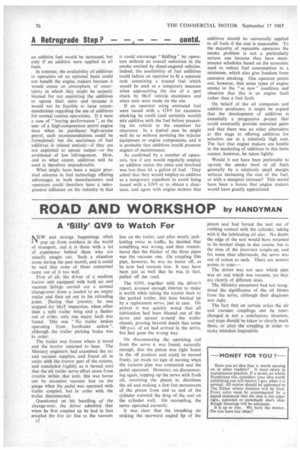ROAD AND WORKSHOP by HANDYMAN
Page 76

If you've noticed an error in this article please click here to report it so we can fix it.
A 'Silly' 0V9 to Watch For
NEW and strange happenings often pop up from nowhere in the world of transport, and it is those with a lot of experience behind them who are usually caught out. Such a situation arose during the past month, and it could be said that none of those concerned -came out of it too well.
First of all, the driver of a medium tractor unit equipped with both air and vacuum fittings carried out a normal change-over from a loaded to an empty trailer and then set out to his reloading point. During that journey, he was stopped for MoT inspection, when other than a split trailer wing and a flasher out of order, only one major fault was found. This was "No trailer brakes operating from footbrake action ", although the trailer parking brake was in order.
The trailer was frozen where it stood and the tractor returned to base. The Ministry engineers had examined the air and vacuum supplies, and found all in order with the tractor part of the system, and concluded (rightly as it turned out) that the nil trailer servo effort arose from trouble within that unit; this was borne out by excessive vacuum loss on the gauge when the pedal was operated with trailer coupled, but in order with the trailer disconnected.
Questioned on his handling of the change-over, the driver admitted that when he first coupled up he had in fact coupled the live air line to the vacuum r2 line on the trailer, and after nearly jackknifing twice in traffic, he decided that something was wrong, and then remembered that the thicker of the three pipes was the vacuum one. On coupling this pine, however, he was no better off, as he now had vacuum toss, It may have been just as well that he was in fact, pulled off the road.
The GV9, together with the driver's report, aroused enough interest to make it worth while taking the tractor back to the parked trailer, this time backed up by a replacment servo, just in case. On arrival it was quickly noted that all lubrication had been blasted out of the servo and spread around the trailer chassis, proving beyond doubt that some IGO of air had arrived in the servo, but had gone the wrong way.
On disconnecting the operating rod from the servo it was found, naturally enough, that the piston was right home in the off position and could be moved freely, yet made no sign of moving when the vacuum pipe was connected and the pedal operated. However, on disconnecting again, topping up the servo with fresh oil, revolving the piston to distribute the oil and making a few fast movements of the piston from end to end of the cylinder restored the drag of the seal on the cylinder wall. On recoupling, the servo operated correctly.
It was clear that the inrushing air striking the rearward angled lip of the
piston seal had forced the seal out of rubbing contact with the cylinder, taking with it the lubricating oil also. No doubt the edge of the seal would have returned to its normal shape in due course, but at the time of the incorrect couple-up, and for some time afterwards, the servo was out of action as such. There are several points to note;—
The driver was not sure which pipe was air and which was vacuum, yet they are clearly of different sizes.
The Ministry examiners had not recognized the significance of the oil blown from the servo, although their diagnosis was right.
The fact that on certain artics the air and vacuum couplings can be interchanged is not a satisfactory situation, and steps should be taken to clearly mark them, or alter the coupling in order to make mistakes impossible.




















































































































































































